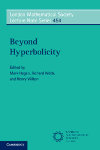- About MAA
- Membership
- MAA Publications
- Periodicals
- Blogs
- MAA Book Series
- MAA Press (an imprint of the AMS)
- MAA Notes
- MAA Reviews
- Mathematical Communication
- Information for Libraries
- Author Resources
- Advertise with MAA
- Meetings
- Competitions
- Programs
- Communities
- MAA Sections
- SIGMAA
- MAA Connect
- Students
- MAA Awards
- Awards Booklets
- Writing Awards
- Teaching Awards
- Service Awards
- Research Awards
- Lecture Awards
- Putnam Competition Individual and Team Winners
- D. E. Shaw Group AMC 8 Awards & Certificates
- Maryam Mirzakhani AMC 10 A Awards & Certificates
- Two Sigma AMC 10 B Awards & Certificates
- Jane Street AMC 12 A Awards & Certificates
- Akamai AMC 12 B Awards & Certificates
- High School Teachers
- News
You are here
Beyond Hyperbolicity

Publisher:
Cambridge University Press
Publication Date:
2019
Number of Pages:
440
Format:
Paperback
Series:
London Mathematical Society Lecture Note Series
Price:
80.00
ISBN:
9781108447294
Category:
Collection
[Reviewed by , on ]
Robert Bell
08/23/2020
Beyond Hyperbolicity is a collection of surveys, expository articles, and original research articles addressed to students and researchers in geometric group theory. A cornerstone of this field is the theory of (Gromov) hyperbolic groups. These include the fundamental groups of compact hyperbolic manifolds and finitely presented groups satisfying certain small cancellation conditions on their defining relators. Hyperbolic groups have remarkable algorithmic properties, enjoy quasi-isometric rigidity, and admit a canonical boundary at infinity. On the other hand, there are many classes of non-hyperbolic groups which enjoy one or more of these properties because they are hyperbolic-like, because they admit less restrictive actions on hyperbolic spaces, or because they act on (suitably) non-positively curved spaces. All of these are in the realm of what is meant by the term “beyond hyperbolicity.” The articles in this collection take the reader on a journey from foundational examples and definitions to state-of-the-art theorems and actively researched open problems.
Ideally, the prospective reader will be familiar with examples and foundational results encountered in a one-semester graduate-level course on geometric group theory, combinatorial group theory, three-manifolds, or a related topic. Someone already working in geometric group theory but who has only a casual acquaintance with any one of coarse median groups, semi-hyperbolic groups, acylindrically hyperbolic groups, the Morse boundary, or hierarchically hyperbolic groups will find this a very welcome addition, as these are the subject of, respectively, the first three surveys and the first two expository articles. The authors frequently use mapping class groups as a source of examples, as these have yielded to various extensions of hyperbolicity and, in some cases, e.g. acylindrical hyperbolicity and hierarchical hyperbolicity, have inspired such investigations.
The collection is suitable for self-study or as the subject of a working seminar. There are many approachable details which are left to the reader, but there are very few exercises per se. In the first five articles, the authors strike a careful balance between imparting the main ideas and the big picture while carefully stating definitions and theorems without diving into the details. There are extensive references which guide the reader to both foundational and highly specialized research articles for those seeking to learn more or to grapple with open problems. Unfortunately, there is no index in this collection. An important direction that is not discussed is that of relatively hyperbolic groups.
Each article can be read independently. Students and those wanting to enter these fields of specialization will want to return to the surveys and expositions for inspiration as they engage with more specialized literature. This book would be at home on the bookshelf next to similar collections in the LMS Lecture Note Series such as the two-volume Geometric Group Theory edited by Niblo and Roller that contains Gromov's follow-up to his essay on hyperbolic groups that launched many of these research programs nearly thirty-five years ago.
Robert Bell is an Associate Professor in the Lyman Briggs College and the Department of Mathematics at Michigan State University.
See the publisher's web page.
- Log in to post comments




